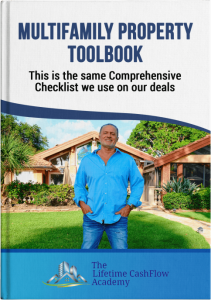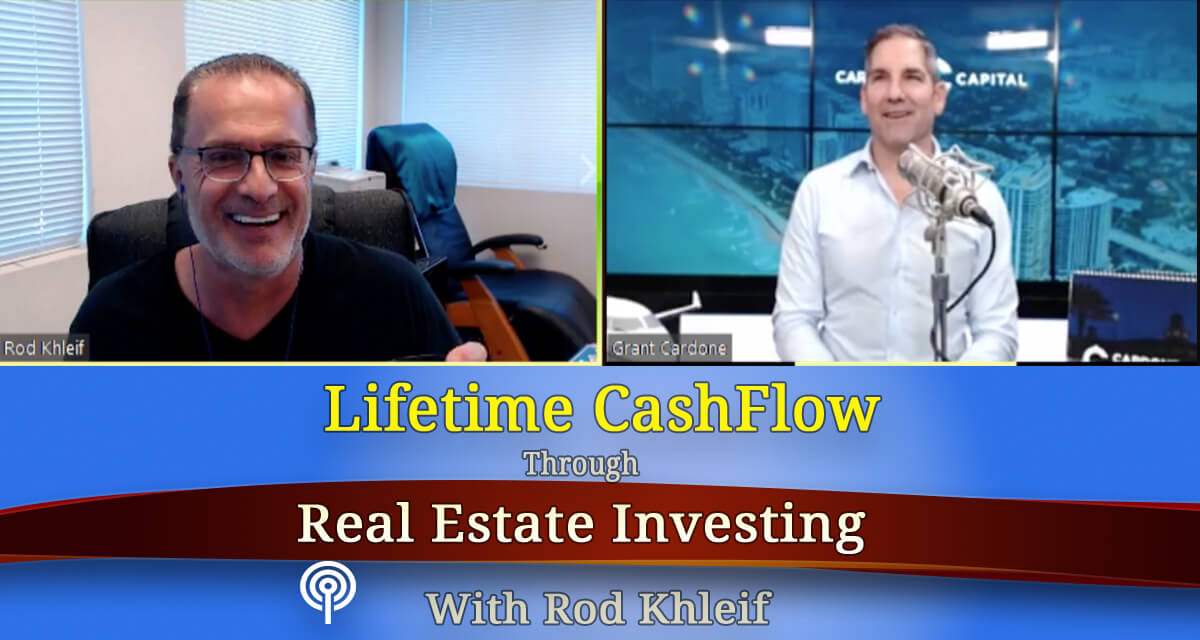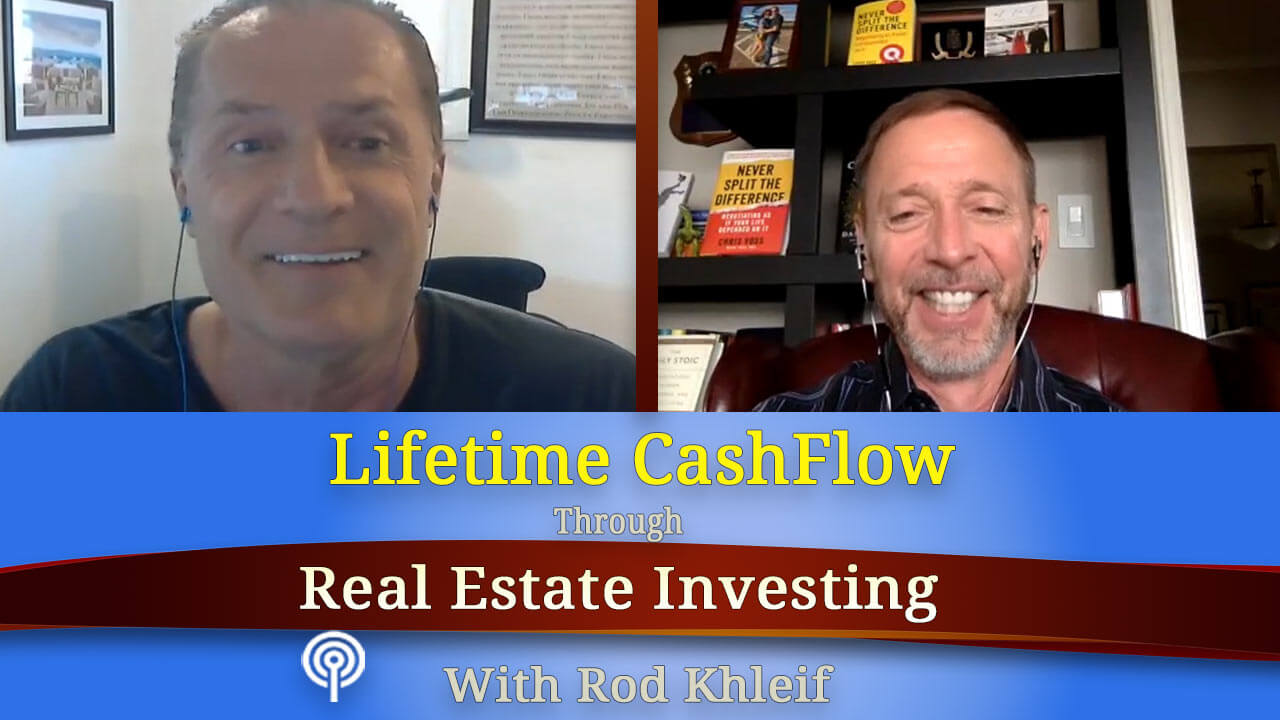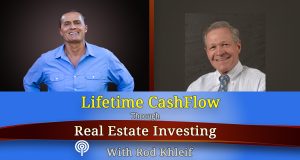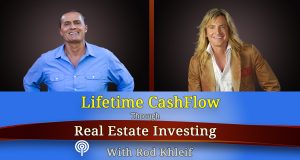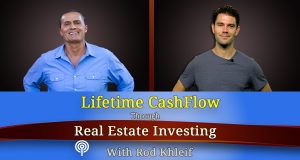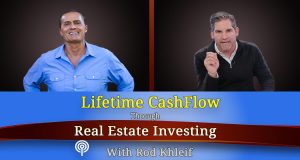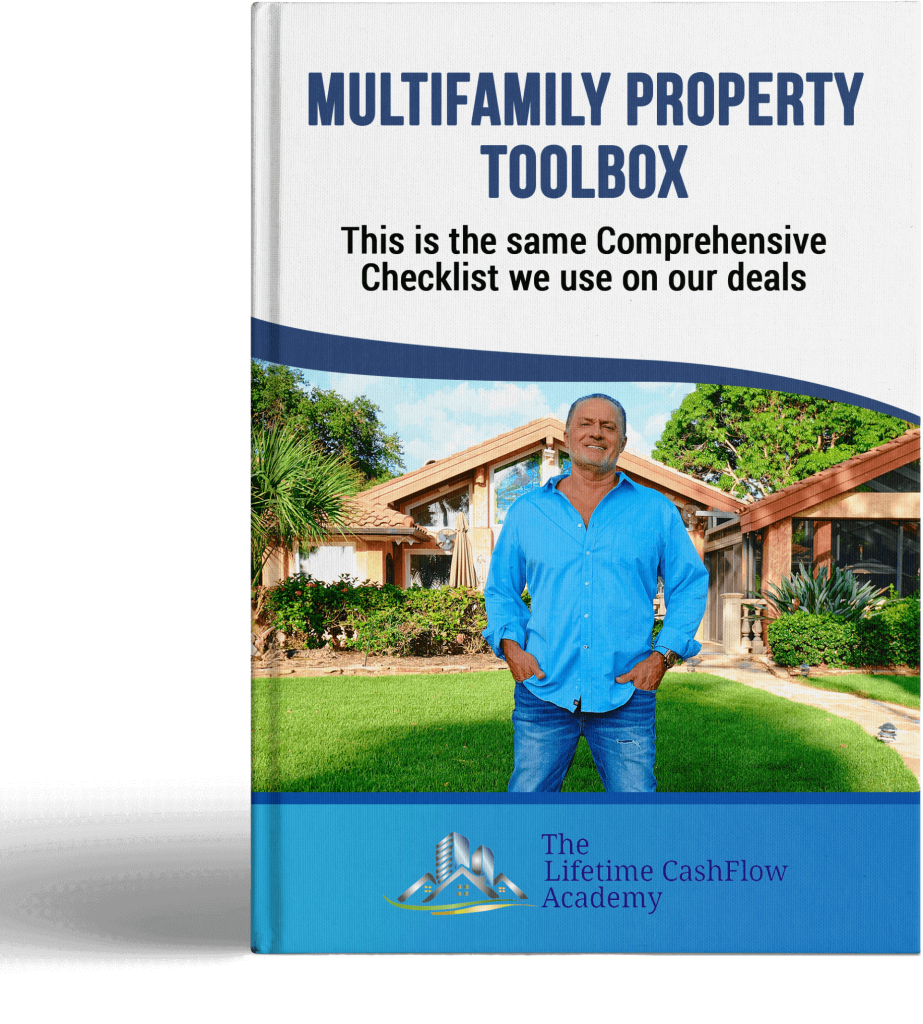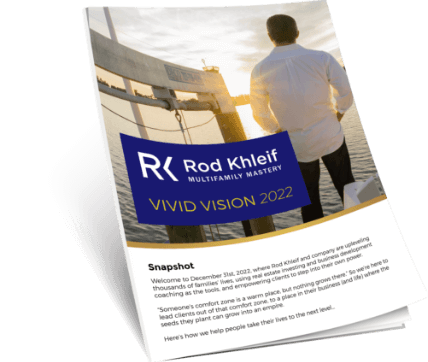Download On iTunes!
Ep #397 – J Scott – The Business of Real Estate
Here is some of what you will learn:
- Business first and foremost
- Understanding your inventory
- Building a lifestyle business
- Systems and People
- Understanding the key segments of your business
- Align with, partner with, or hire
- Defining and planning for success
- How to hire great employees
- Why passion and excitement trumps experience
- Why branding is a daily decision
To find out more about our guest: click here To find out more about partnering or investing in a multifamily deal: Text Partner to 41411 or email Partner@RodKhleif.com Join us at a Multifamily Bootcamp, visit: MultifamilyBootcamp.com
Full Transcript Below:
Ep #397 – Jay Scott – The Business of Real Estate
Rod: Welcome to another edition of How to Build Lifetime Cash Flow through Real Estate Investing. I’m Rod Khleif and I am thrilled that you’re here. And we have a real treat today and it’s a real treat because this gentleman is part of the Bigger Pockets Family and if you haven’t if you haven’t listened to the Bigger Pockets Podcast and I don’t know what rock you’ve been hiding under but it’s been them or me in the first place spot under real estate on iTunes for the last three years. It’s usually them first place. So often I sneak ahead but very rarely. They are like the 800-pound gorilla in the real estate space. But the gentleman I’m interviewing today’s name is Jay Scott and he actually is the co-host of their business podcast, Bigger Pockets business and so this is gonna be a real treat for a whole lot of reasons because we’re going to talk business today and we don’t talk about that much on his podcast but what is you know if you’re gonna do this if you’re gonna do this multi-family let me rephrase that, when you do this multifamily game it is a business. You’re taking off your employee hat and you’re putting on your entrepreneur hat and you got to turn this into a business. So we’re gonna have a lot of fun. So let me tell you a little bit about Jay Scott. He’s written lots of books. I think four books and sold over 200,000 copies. He did a book on flipping houses and again he’s co-host to the Bigger Pockets business podcast and he’s you know built, rehab, sold, as somewhere in excess of $50 million worth of property and loan money on it. He’s got a website called 123flip. We’re not gonna talk about flipping today because that’s not this this syntax here but we’re gonna have a lot of fun and I’m really looking for this conversation. Welcome to show my friend
Jay: Thank you so much. I am thrilled to be here
Rod: That’s so kind of you to say that. So you know why don’t why don’t we do it start like we always start which is having you tell my listeners a little bit about you and before we dive right into questions and having fun
Jay: Yeah absolutely so I started, my wife and I started in the corporate world for a long time back in 2008 we decided to get married and we were both doing that typical big corporate thing working 80 hours a week, traveling all the time. It just wasn’t conducive to starting a family so back in 2008 when we decided to get married we said, got to cut this out we got to do something that is more lifestyle oriented something that would allow us to focus on the family, having kids, raising kids, but also it allow us to continue to make money and to continue to build our nest egg. So long story short we fell into real estate. We quit our jobs moved from the west coast Silicon Valley to the east coast and back in 2008 we kind of fell into real estate at what was a lot of people say the worst time in history to be investing in real estate and flipping houses. Turned out that it actually wasn’t the worst time in history was actually very good. A lot of people were scared
Rod: Best time
Jay: Absolutely
Rod: As far as I’m concerned
Jay: Yeah absolutely. People asked me what my key to success is and honestly if I had to rank them, the number one would just be pure timing. Yeah I mean, I didn’t know what I didn’t know back then I didn’t jump in because I said this is the perfect time to be in real estate I just kind of fell into it and I look back ten years later and I realized I was tremendously fortunate that the timing was just perfect
Rod: Yeah I was hiding underneath a rock then you know I had 800 houses here in Florida and several apartment complexes in ’08 and ’09 and I got my ass handed to me and I lost it all lost 50 million dollars I don’t know if you knew that but you know what else is kind of cool about Jay here is that he moved to Sarasota and he’s actually living the same freakin subdivision that I used to live in which is just awesome. So you know I can’t wait to have lunch with you brother but yeah you know I was hiding underneath the rock I and is such a missed opportunity but I was licking my wounds for a few months and then I really didn’t want to think about real estate for a short while but, so you’ve also been involved in business, yes? I mean talk about I mean corporate business obviously you know they invited you to host their business version of the Bigger Pockets podcast which I’m really interested to talk about. Can you speak to that a little bit and maybe some of the topics that you cover on your show? And then let’s see what we can do to add value to my listeners about creating a multi-family business
Jay: Absolutely, looking forward to that. So my background is, I spent most of my career at Microsoft. I managed one of their businesses. They had an interactive television business. So if anybody that’s familiar with TiVo, that was basically a TiVo business that Microsoft ran long time ago. So I managed part of that business for a long time. I did some M&A mergers and acquisitions at Microsoft and so that was my kind of corporate experience. My wife and I had been partners forever she ran marketing and eBay for a long time. So we kind of both came out with this great business. I was a product guy she was a marketing person so we kind of went into business together in 2008 and we’ve started a number of businesses. So we’re best known for being house flippers probably because I wrote the book on flipping houses and I’ve talked a lot about flipping houses. A lot of people we don’t talk about as much but we’ve bought several businesses, we run several businesses and so that’s kind of business is a passion for us and we like to talk about the fact that as real estate investors, we don’t think of ourselves as real estate people, we’re business people who, one of our businesses happens to be real estate and you said it yourself as multifamily investors as any investors, first and foremost you’re a business person. And for some reason I think real estate kind of gets this reputation that, yeah you can do it as a hobby. You can do one or two deals and you can make some money and yeah that’s true you can but true real estate investors, real estate investors are actually business people. And the houses or the apartment complexes or the mobile home parks or whatever it is you’re dealing with, that’s just your inventory and you could be buying and selling shoes you could have a shoe store you could be a restaurant that’s buying and selling food. You could be a car dealership buying and selling cars. That’s your inventory as real estate investors houses, apartments, mobile homes, whatever that’s our inventory and so we have to think if we really want to scale our business if we want to optimize our business, if we want to minimize our risk, if we want to set ourselves up for success, we have to first and foremost think of ourselves as business owners.
Rod: Couldn’t agree more
Jay: And we need to treat our investing as a business and if you do that you’re gonna find that you’re a lot more successful, you’re a lot less stressed, you can scale your business better, you can put in fewer hours but accomplish more, and most of all you can minimize a lot of the risk not that real estate is tremendously risky, but any business is risky but if you treat your business like a business, you can mitigate a lot of that risk
Rod: Yeah I love it. You said a lot and I want to circle back on a couple of quick things. Number one, guys you know most of you aspiring to get into this business, who still have your core W-2 jobs still out there doing and this multifamily gig as a side hustle. It is critical, like Jay just said, you’ve got to take off your employee hat and put on your entrepreneur hat because it is a business and any business, by the way, is nothing but people and systems. Peter Drucker said, “Any business is innovation and marketing” and I agree with that as well but it really is your ability to create systems so that you have lifestyle. And in fact I’m dealing with that right now in my thought leadership business you know we’ve got lots of coaching students, I do these three-day live events, and by the way guys, L.A. the early bird tickets are almost sold out. Be sure you get your, go to rodinLosAngeles.com and get your tickets. We will sell out totally. There’s tickets are really going like crazy for that event and as you know it’s just me for three days teaching you about this business so make sure that you get your tickets soon. But any business and I’m working on that in my thought leadership business right now. I just hired pretty much a whole C-level team to implement you know I’ve got a CEO, a co-CEO, a Chief Marketing Officer, Chief Financial Officer and a VP of Sales and so we are right in the process of setting up and implementing our systems and our KPIs or key performance indicators to build our business in fact we’re introduced, we’re on using the EOS system which I’m sure you talked about on your podcast the from the book “Traction” and that’s what we’re using to get our business going but the key thing here is and you talked about this before we started recording you were flipping 50 houses I think you said I don’t know what period of time but you were working five hours a week. So lifestyle is another component. You want to talk about that for a minute?
Jay: Yeah absolutely. I mean remember we left our corporate jobs. We were literally with stock and options left seven-figure jobs to start another business and we weren’t doing that first and foremost for the money if it was just the money we cared about we would have stated and our W-2 jobs we left because we wanted to be able to put our family first in our lifestyle first so for us, we still wanted to make a lot of money but if we couldn’t do that without systematizing our business, without putting processes in place that allowed us to work a whole lot less than that 80 hours a week we’re doing in our corporate jobs, we were doing it for nothing. So we needed to figure out how to have again a lifestyle business and that’s somewhat of a misnomer. I mean even with the lifestyle business you need to be a business owner you need to focus on your business that needs to be an important part of your life but we needed to figure out how to accomplish everything we wanted to accomplish in not a lot of time
Rod: Yeah and I’ll tell you my greatest regret in life as many of you’ve heard me say this before specially if you’ve seen me speak live is, I’d come home I had a house on KC Key here, big 8 million dollar I call it testament to my ego that I built here and I’d come home and play with my kids but I was distracted, every single time is my greatest regret in life to this day my kids you know they help up at my live events and they’ll tell you I was a great dad but I didn’t live up to my own expectations. So I didn’t get this memo until later in life and so you know this is really important guys. I know a lot of you listening are hungry, you got blood dripping from your teeth and you want for success no matter what, and I’m here to tell you don’t give up. What’s more important that’s those relationships that are in your life to achieve that success because it’s not success. So let’s talk about some of the components of a business. Let’s talk about some of the, maybe you can give some strategies around building a successful business and I wrote down some topics here like, because we just, by the way guys, we just came up with this right before the, like hey you know your business primarily single-family and flippin how we gonna add value to my listeners and we’re like, and I’m like and he said my business like hell yeah because that’s really what this is. So I wrote down hiring, I wrote down culture, marketing, branding, you know building reach. So why don’t we start with the hiring piece, that people piece because that really is would you agree, one of the biggest pieces of business?
Jay: Absolutely it but if you don’t mind I actually want to step back one level above that okay because everything you mentioned is tremendously important when it comes to building and growing and scaling and optimizing a business right. There’s one thing that I found needs to come first okay and that is understanding the components, I call them segments, so understanding the key segments of your business. And this is something that a lot of small business owners, a lot of investors, they never think about but if you go to a medium-sized company, if you go to a big company, the first thing you’re gonna notice is that the company is broken down into pieces, into segments, into teams or groups, whatever you want to call them. So for example you’re gonna have the marketing department, you’re gonna have the sales department, you’re gonna have a product group, you might have an engineering group, you might have a Quality Assurance group, you might have a customer service group,
Rod: Finance
Jay: Finance, exactly. You have all these different groups you might have twenty or thirty groups if you’re in a big enough company and what you notice is that people are dedicated. People do their jobs so you walk into the marketing department and the people in the marketing department what are they focused on? They’re focused on marketing. They’re not writing software. They’re not doing quality assurance or testing. They’re not there they’re, like defining the product. They’re not the legal team. They’re marketing and you walk into the engineers group the engineers aren’t focused on accounting. They’re not focused on the marketing. They’re focused on writing the code. So we need to be doing the same thing in our business. The first thing we need to do in our business is we need to define what these departments or I call them segments are in our business.
Rod: So let’s talk about them as they relate to multifamily if you don’t mind Jay. So what are some examples of segments in the multifamily space?
Jay: Sure. So some of the big segments, and the multifamily and again every business depending on how you run your business how you think about your business is gonna be a little bit different. Before I, and I’m happy to talk about that but let me throw out a strategy that people can do to kind of figure out what’s right for their business. If I throw something out everybody say, okay, those are my segments. They may or may not be. But one of the things I like to do every time I start a new business and I want to figure out what these segments are, I take a sticky pad just these small sticky notes and I write down every single task that I can think of in the business. So in my flipping business it was, I need to find properties, I need to find contractors, I need to close deals, I needed to get inspections, I need to do this, this, this. Exactly, and if you break it down small enough you can literally get hundreds or thousands of these sticky notes and then you take those sticky notes and you start putting them up on the wall and you start organizing in just some fashion that makes sense and what you’re gonna find is that at the end of the day you’re gonna have two or three or five or ten big buckets of sticky notes. These are your departments or your segments. In my flipping business I had four of them. So my flipping business I had acquisition so everything that went into finding properties and in the multifamily space acquisitions positions gonna want a core component, in my flipping business I had my second piece was rehab
Rod: Rehab yeah remodel
Jay: Yeah so everything that had to do from the day I closed on the property to the day that it was ready to be put back on the market. Third piece of my business was disbursement. So marketing and sales so basically everything that happened from the day the property was ready to be put back on the market to the day that the property was closed the day we actually got our check. And then the fourth bucket was all the fundraising. And so in my flipping business those were my four segments. Every single task that I did day in and day out over a decade fell into one of those four buckets. I never found a task that didn’t fall into one of those four buckets. Now in the multifamily space your buckets might be a little bit different and people
Rod: Let’s talk about some of those. I’ll throw some out and we’ll rift back and forth on this. So of course you’re gonna have acquisitions but of course there’s gonna be a lot of pieces under that broker relationships maybe direct to seller marketing. So those are gonna be lots of subcategories. I love the way that you simplify it though because that that takes the big and makes it small and you need to do that in your mind as well. So this is very powerful exercise. So you can
Jay: Keep in mind yeah after you get these segments you have to define your sub segments. So under these four, my flipping business there were 10 or 20 different sub segments of each of these. So yeah absolutely so yeah acquisition is gonna have a whole lot of sub segments
Rod: And so another big category would be finance okay. Well another one let’s say due diligence ok so due diligence would be it could be a category it could be part of acquisitions could be under acquisitions but it is a big piece and by the way little plug, guys if you haven’t downloaded my due diligence book, it’s on my website it is freaking incredible. It’s almost 70 pages of every possible question you would ask yourself when you’re evaluating a multifamily property and it’s freaking free you know I used to have my book on there I gave away 20 thousand copies in my book and my team finally said, hey stupid let’s put it on Amazon and make some money. And so it’s finally on Amazon but now I’ve got this thing and it is so good. So there’s no fluff in it and its on the Rod Khleif site. So just go get it because what’s great about multifamily business is it’s primarily empirical. Its numbers. If you all things being equal you ask all the right questions and you get the numbers right it’s pretty freakin hard to make a mistake. So get the book. But back to categories, so we’ve got acquisitions, we’ve got due diligence, finance, so in the multifamily space you’re gonna have to figure out early on but fact before you put a property under contract, what the financing is that you’re gonna utilize to take down that property. So that’d be a category and it maybe it’s just the whole capital stack including equity finance everything could be a category. Let’s see what are some other categories of course asset management would be a category. What are you going to do after you buy? You know are you gonna hire a third party property management? you’re gonna do it yourself? That would be a category. And maybe what’s that?
Jay: Construction management.
Rod: Construction. Absolutely. You’re reposition. Thank you for sure how are you, you know are you gonna do it in-house? you’re gonna let the property management company help you with it? you know how you gonna handle that? So love it man. So guys when you break it down like this then you really understand the business. So once you’ve got these categories and then you put the subcategories underneath them Jay, what’s next?
Jay: Yes. That’s when you jump into all of those things that you were talking about before. One of the big one’s is delegation and actually finding people to cover each of those areas. Now a lot of us think, okay I don’t know how to delegate. I don’t know who to bring in. I don’t know the right people. I don’t know the right tasks what should I have them do. But the nice thing is, once you have these segments, once you have these big segments and these sub segments, it gets much easier to say let me find somebody. So if you have let’s say one of your sub segments as construction management. You can bring in a person whose job it is is to run that piece of your business. And so they’re ultimately responsible for putting in place the systems, the processes, the documentation, the set of KPIs for that particular piece of the business. You have another piece of the business that let’s say Investor Relations. You can bring in somebody whose job it is to figure out the staffing of that piece and the documentation of that piece and the and the core KPIs for that piece. Then if the next piece is acquisitions. You can bring in somebody that can do that. Maybe you’re doing all of these things yourself but at least now you have a structure for how you spend your time. I’m gonna spend the next four hours working on optimizing the acquisition piece. I’m gonna spend the next two days focused on the Investor Relations piece. So instead of just going back and forth between random tasks you now have a way of thinking about the pieces of your business and you can say today I’m working on this or for the next hour I’m working on this piece. And then as your business grows you’ll see opportunities to bring somebody in or bring in multiple people to cover various segments or some segments in your business. So delegation hiring absolutely huge and keep in mind you don’t necessarily have to hire full-time employees. You can bring in partners, you can hire contractors, you can browse
Rod: I was just gonna say that. That’s good
Jay: You can bring in temps. So when we talk about delegation don’t necessarily think delegation involves having to hire full-time people because that’s expensive, that’s difficult. There are lots of solutions for delegating out work
Rod: I’m so glad you said that because I was gonna stop you if you moved on to the next segment because guys you don’t have to have a huge wallet filled with money to hire all these people like I said, you can partner and that’s how most people start frankly. Now let me say this as a caveat before I move past this you know partnerships like a marriage easy to get into and very hard to get out of and I mean I run you know, I run the multifamily boardroom mastermind is almost six billion in assets in there and there are some heavy hitters in there. They’re splitting up their partnerships you know and they’re not always pleasant. So if you’re gonna do a partnership, I’ve created this document that’s got a bunch of all the questions you should ask yourself the hard questions upfront before you get into a partnership and the first question is do I really need this partnership? If you want that DM me on Facebook and all I’ll give it to you. So be careful what I wish for. I’m sure my email is gonna blow up now. But if you want that, I’ll give it to you. It’s a list of, I don’t know, about ten pages of the right questions ask before you get into a partnership. So you know one thing I might add to what you just said Jay is you know you’ve got these segments and you’re looking at who you might need to align with, partner, hire whatever to do these things, do you think there might be some benefit to creating a quasi org chart around those segments with some blank boxes and what an organizational chart is guys is taking the different pieces of your business like on a tree with the you as the CEO at the top and then you branch out in all these departments and your name might be in most of those boxes when you start but then you can identify who you might want to bring in. Would that maybe kind of help a little bit? What do you think?
Jay: Absolutely. I mean this is, imagine your business 10 years in the future and what roles are you gonna be filling? And like you said, you don’t need a name for every one of those positions maybe you have 30 different positions on your org chart and you’re in 29 of them. Maybe you’re in all 30 of them but, this gives you a structure for the day you go out and you hire your first person or you partner with somebody or you bring in a temp or you bring in a contractor. You can say this is your role, this is your position, and their name goes there and then maybe two months later you bring in somebody else and six months later you bring in somebody else and the goal is in two or five or 10 years you now have a full organization that’s supporting itself and that has each roll filled. It’s basically planning for success and defining what success looks like two, five, ten years into the future and building your company based on that vision as opposed to just letting it grow getting 10 years down the road and saying, oh wow I have all these people and I still don’t know what I’m doing
Rod: Yeah I agree completely. And guys in anything in life, clarity is power. And the more of this you do in anticipation of building this business of yours in the multifamily space, the more clarity are gonna have. So this is really good. I’m really glad we’re doing this today Jay because we’ve never done this on the show. So now let’s drill down on some of these topics that I mentioned because again, you and I know that really it is all about the people you bring in the people you align with if you’re gonna partner by God you know one thing let me mention one other thing there, trust your gut, trust your intuition. You know I turned 60 in 30 days and I’ve had a lot of great partnerships and I’ve had some not so great partnerships and I will tell you almost every time they’re not so great ones have been when I haven’t listened to my gut. So if it doesn’t feel right, trust that my friends okay very important. Would you agree with me Jay?
Jay: A hundred percent and I think too often we get desperate to bring in people to help us. We get desperate to find a partner because there’s something we don’t want to do or can’t do or we get desperate to hire somebody because we just need somebody in a particular role. I mean we see this with contractors all the time that you interview a contractor, he’s like I’m not sure if he’s right but he’s available and he says he can start tomorrow and I just don’t have anybody else so I’m going to hire him and what you find is you end up spending more time and more money and more stress and more effort and more headache when dealing with that person that seemed like he could just get the job done even though he wasn’t perfect then you would have just saying no I’m gonna wait another two weeks. I’m gonna interview more people and find the right person
Rod: Yeah so important. I remember I was hiring a COO for another business. I built 24 businesses in my lifetime and several been worth a lot of money and but most have been seminars and you guys all know what that means but I was gonna hire this COO, it was a high-level position. I think it was a buck 75 was the salary and we went to dinner, Tiffy and I my wife and I took this guy and his wife to dinner and I was ready to hire him, but there was one little thing he did it was subconscious it was just a slight bit of arrogance with the waitstaff and I’m like you know what I want to dig in a little deeper and he had had one reference on his resume. He said don’t call this guy because he’s dying of cancer. And I’m like you know what I’m gonna call the guy and he wasn’t dying of cancer and he said don’t hire this guy. He stole from me, you don’t want it like it was just that little thing about the intuition that cause that. Anyway I digressed. So how do you find the best people brother? What’s your advice or do you have any any suggestions around that piece?
Jay: Yes so here’s the thing I see too many people business people whether it be investors or otherwise doing when they’re looking to hire. they say
Rod: or your partner or align
Jay: Exactly right, yes this fits into any of those I say, here’s what I’m looking to get done. Let’s say, they say, I need a receptionist and they say the receptionist is gonna do this. They’re gonna answer the phones, they’re gonna do customer support, maybe they’re gonna do invoicing, maybe they’re gonna do paperworks
Rod: All the tasks
Jay: Right, this could be any role but let’s just use as an example. And then they go out and look for somebody who has experience dealing with customers and dealing with paperwork in dealing with invoices and they try and find somebody that has the perfect experience. And in my experience, you shouldn’t be looking for somebody with the perfect experience. Go find a great employee and figure out a role for them. And it doesn’t have to be the role that they’ve done in the past. It doesn’t have to be what they have experienced. It’s easier to take somebody who is an all-around good employee and training them in a task or a role than it is to take somebody who has a lot of experience in a task or a role and turning them into a great employee that fits your culture
Rod: Boom! Guys I hope you heard that. I have hired hundreds literally hundreds of people in my career over multiple companies and I finally got the memo on this it took me a while. I will take work ethic and passion and excitement over experience any freaking day. The technical side can be taught. You can’t teach the work ethic. You can’t teach the passion and the excitement about the business. You agree Jay?
Jay: Absolutely. My wife walks around with business cards and will be at a restaurant and will have a great experience with a server and she will just hand them a card and say hey, if you’re ever looking for another job, call me. What are you looking to hire for? I don’t know we’ll figure it out just call me. And a lot of times, it’s customer service like people because our, we consider one of our main core competencies what we consider our competitive advantage and all the businesses we start is we strive for amazing customer service. And so for us having people that are polished that had the right attitude
Rod: that care
Jay: that care yeah. When you find somebody like that, you can train them to do anything yeah and it’s a lot harder to take somebody that’s really well-trained in something and try and convert them to having your core values. That’s the much dream
Rod: Agreed. And guys you know there are a lot of books on creating culture and core values and a mission statement. Traction is a great one. The Rockefeller habits is I think where some of the “Traction” came from. We’re actually implementing that system, that EOS system out of “Traction” right now into my business. It’s been real eye-opening but the point is you know educate yourself on you’re not just gonna educate yourself on multifamily you’re going to educate yourself on building a business, on hiring, on sales, on marketing, all these components of a business. But let’s talk about culture just because I wrote it next and something that I believe in you know when you’re building your business you do have to have, you as the CEO you have to have a mission and a purpose in what it is you’re trying to accomplish because and with some clarity because how the hell are you ever gonna rally anybody behind what it is you want to do if you don’t know what it is? Would you agree with me?
Jay: I absolutely would and I’ll tell you, I am not the, my wife is more the touchy-feely marketing emotional side I’m more the I have an engineering degree and I’m more the analytical one. I’ve never been big on like vision boards and stuff like that but I had the privilege of interviewing a guy named Cameron Harold.
Rod: He’s wonderful guy. I’ve got his book. I’ve got his book right here in my briefcase. One of his books wonderful guy yeah yeah
Jay: So Cameron’s fantastic. So he is kind of the COO a guy that’s has been his role. He grew 1-800 his big claim, 1-800 got junk. He grew it like a billion-dollar business and he runs an organization called the COO Alliance, the Chief Operating Officer Alliance and he wrote a book called “Vivid Vision” and basically in the book it talks about to basically set yourself up for success in your business, you need to create a vision document. And it can be any format you want to a newspaper article
Rod: Okay I’m sorry I have to interrupt because it’s killing me I literally just hired somebody. I have their contract in my inbox right now to create that vision for me. Literally, it’s so funny that you’re talking about this. The way the universe works blows my mind. I literally have a contract in my inbox came in this morning to have my vision created for my company. So I’m sorry it was killing me not to say so
Jay: No that is great and he’s fantastic I mean he was one of the people I was really excited to have on the podcast when I started my podcast. And so for anybody out there pick up this book it’s called “Vivid Vision”
Rod: Oh yeah his stuff is awesome. He’s got another book called “Free PR” which is the one I have my briefcase right now it’s right here. And so that vision and what I’m doing with my company is we’re gonna create like you said, that vision for the future and it’s actually a document with graphics and it’s going to be beautiful and we can show that to a prospective partner or employee or anybody, contractor, that’s gonna align with us and they’re gonna know exactly where my head is at and where I want to take the company. Awesome, I’m really glad you brought that up
Jay: And not only will it align them but to show that to a prospective partner or customer my customer but maybe even a customer
Rod: Yeah maybe a customer
Jay: or employee and you say this is my vision, this is what our culture looks like, this is what we’re looking to grow and they can look at that and they can say I’m not gonna fit in well. That’s not my vision and that’s great. You have to have somebody that that self-selects out and says, this isn’t right for me than somebody that comes in blind and says this is gonna be great and then they get in there and go oh no this guy’s, the his core values just don’t align with mine his vision doesn’t align with mine. So it’s basically it’s a way for you to express everything about you and that business in a way that everybody you work with can either self-select out or say yes I’m on board with this. And nobody will ever come into your business and say well I when I took the job I didn’t expect that no you know exactly what to expect because here’s my vision.
Rod: Yeah I love it love it yeah I mean I’m really looking forward to that process cuz they’re gonna walk us through the whole process and you know the things that I’m passionate about giving back, and my charitable of stuff and if that’s you know if that’s not you this isn’t gonna be the place for you you know and so let’s talk about branding a little bit because I would have to say you know you and I each have done a fantastic job in that arena. So you know and what’s so amazing about the place we are in time right now it’s just incredible the opportunities available to brand. I mean I’ve got you know I’m on, I try to help brand-new podcasters, I’m literally, probably eight podcasts a week just to try to give them give them a little juice and push and some advice and stuff but you want to speak to branding a little bit?
Jay: So branding is definitely not one of my forte but I’m happy to talk to. My wife, I’ve learned a lot from my wife. So my wife has done branding for some of the largest companies of the world. She was at eBay and did marketing and branding. She was at Franklin Covey the Seven Habits people
Rod: Wow
Jay: Did a lot of more branding.
Rod: I should have had her on the show for God’s sakes man
Jay: It’s not too late. I’m sure she’d love to come on but yes. So branding is, and this goes along with your vision. So some key components of branding are one don’t let your brand define itself. Don’t let your brand evolve. Branding is a decision you make every day. Branding is a way that you decide you want your company to be reflected and you need to build that. And if we let our brand evolve naturally, it’s not gonna evolve in a focused fashion. And so couple things you need to be true to your brand you can’t define a brand that’s not really you. I can’t define a brand that’s all about whimsy and this and that because I’m
Rod: You’re an engineer. Right got it
Jay: So I need to have something that’s aligned with my values and my personality but once I do that, I need to define what that brand is and I need to define what that brand is trying to communicate about me, about my business. And then you have to live and integrate that brand into everything you do. It has to be integrated into the people you hire it has to be integrated into the marketing materials you create. It has to be integrated into your customer communications. It has to be integrated into every facet of your business. And if you can’t figure out how to integrate your brand into every facet of your business then it’s not the right brand for you right
Rod: You know I probably shouldn’t have said brand I should have said create reach because there’s not a lot of branding around multifamily, it’s really more, I mean yes I mean you should you should think about what you’re going to stand for and what your core values are and what your mission is and you know at providing quality housing maybe for your residents but really where I should have went with this is creating reach because that’s really what we’re, you’ve done an incredible job through the BiggerPockets family and my podcast you know with millions of downloads like you guys and talk about the opportunities to create reach today because the multifamily space you know, it’s a team sport. It requires equity partners. It requires investors you know you know and it’s so easy now to create that reach. You want to speak to that a little bit?
Jay: Yeah absolutely so my, M.O I guess you could say for creating reach and doing more and growing and building relationships has always been pretty simple. For me, it’s all about giving value. And my attitude is, every day my goal is to sincerely give value. There are people out there who say I’m gonna give value and they’re doing it with it that in the back of their mind how am I getting get this back? Every time they do something there they’re sitting there thinking how is this gonna come back to me? I don’t think about how it’s gonna come back to me. I know that if I give enough value if I put enough out there to help other people, it’s going to come back to me and it’s not
Rod: I have to stop you because I have to give you a shout out. Before we started recording remember I asked you the question how can I add value to you today? And you said, I’m good man. I’m just here to.. and so guys he truly means what he says here and the most successful people on the planet are the ones that had the most freakin value. So he got the memo I got the memo. I mean in, so hear this guys. When you’re out there, whether it’s on Instagram, Facebook, LinkedIn, YouTube, Pinterest, Twitter, whatever it is, that’s the number one focus, value
Jay: Absolutely yeah and do it consistent, consistently & sincerely and I learned this lesson. Iknew this lesson before but it was it was really driven home, there’s a guy named Jay Papasan and Jay is Gary Keller’s partner. So he runs Keller publishing. So if you’ve ever had written
Rod: One thing, Gary Keller is the guy that founded Keller Williams. Brilliant
Jay: Yeah and so Jay Papasan is the co-author of “The One Thing” and so I’ve had the opportunity to talk to him a few times. I had him on my podcast and I remember the first time I talked to him, somebody introduced us and the first thing he said when he jumped on and keep in mind, Jay papasan is I mean he’s a New York Times bestselling author. He’s ridiculously wealthy. He’s ridiculously successful and probably a million people like looking for his time and help and so I get on the phone call with him and the first thing he says to me is he said, and the most sincerely anybody’s ever said this to me he said, what can I do right now to add value to you?
Rod: What a great question
Jay: Yeah and I said, I hadn’t even thought of that question and what I said to him was, I haven’t even thought about it. Okay if I think about he said absolutely and then when there’s something you let me know what that is. And at that moment I’m sure their thing there are plenty of things I could have asked him that he wasn’t willing to do but he just the way he said it was just like I could have asked for the world and he was he was willing to give it and we had about a half-hour conversation and that first time and it was constantly about how he could help me, how he could provide value, how we could make the most of that discussion so that I would walk away feeling like that was, it couldn’t have been worth any more of my time that was the the most immense value and every conversation I have had since that conversation this was about a year ago every conversation I’ve had since then I’ve tried to replicate how he made me feel with the other person. And what I found is the closer I can come to actually doing that sincerely like really just not looking for anything in return, the more I find it comes back to me
Rod: I love it man. I love it. What a great shout out to Jay Papasan and just great for me to hear it as well again because guys you know whatever you give you get and you guys know this you’ve talked about it ad nauseam on this show. You want happiness, give happiness. You want love, give love. You know you help other people succeed in business, you will succeed in business. It’s just the way the universe works. So how’re we doing on time we’ve got a little bit of time um I unfortunately have a hard stop in 15 minutes but let’s keep going here branding, reach, so give us some secrets to success Jay. You’ve super successful in what you’re doing talk you know talk to some of the young people that are listening that maybe haven’t bought their first property yet, know they want to do this, for whatever reason they haven’t taken action, fear, comfort, limiting beliefs, whatever, share some wisdom with these with these aspiring investors
Jay: Yeah here’s the biggest piece of wisdom I have for any real estate investors out there that are looking to do their first deal. I meet and I have met and I’m sure you’re you’ll probably agree with everything I say here. I’ve met thousands, maybe tens of thousands of real estate investors and aspiring real estate investors over the past decade. And in that time I found that every single investor that I’ve met has fallen into one of two categories. They’ve either done zero deals and I’d say probably more than half of them fall into the category of having done zero deals or they’ve done two or three or five or ten or 50 deals. I very rarely if ever meet an investor who’s done one deal. No investors do one deal you either do zero deals or you do a lot of deals and the reason for that is as soon as you do that first deal, everything clicks, everything comes together and you realize, wow I get it, I understand the formula, I understand what’s going on here and as soon as you do that first deal, that second one comes so much easier, that third one comes so much easier the fourth one comes so much easier, the tenth and fiftieth comes so much easier. It’s getting that first deal. And what I want to tell everybody out there who hasn’t done that first deal is, don’t stop until you get that first deal because once you get that first deal, I promise you you’ll get a second and a fifth and a tenth and the fiftieth because that’s the way it works. Nobody does one deal
Rod: Yeah awesome advice. The law of the first deal for sure because I’ve got students you know and in after that first one they’re like dominoes now they’ve got thousand or two thousand. They’ve quit their job. I mean it’s just incredible to see that in action. The first deals always the hardest, it’s the most stressful, takes the longest. But then you’re like you do and you’re like is that all there was the fear is gone. Now I know how to do it. I love it buddy, great advice. Well listen, I really appreciate you being on the show my friend. I had a tremendous value and on a topic we’ve never discussed before. So this has really been a treat for me and we got to get together at lunch soon in my backyard. We got to make that happen but I really appreciate you being on the show and I look forward to getting to know you my friend.
Jay: Fantastic thanks Rod.
Rod: All right take care





